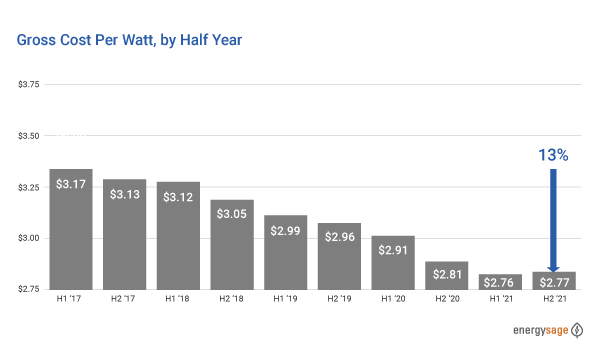Solar panel technology has been around for a while. Scientists have known for centuries that the sun can be used to produce energy. However, it is only in the last ten years or so that solar photovoltaics (PV) has really taken off as a renewable energy source. Solar panel cost and solar panel efficiency have both improved steadily over time, which has helped PV grow in popularity.
Solar panel efficiency over time
The first solar cells, invented in the 1800s, were not very efficient. They did not produce enough energy to be useful. In 1954, Bell Labs invented the first useful silicon solar panel. This panel was six percent efficient.
Solar PV technology has rapidly evolved in recent years. Manufacturers have created prototype solar panels that are over 30 percent efficient. Homeowners using the EnergySage Marketplace regularly receive quotes featuring solar panels with 20 to 22 percent efficiency from solar installers. These high-efficiency panels can produce 25 percent more electricity than the lower-tier economy panels that made up the majority of the market in past years.
Solar panel efficiency can be improved even more. Scientists have found a way to improve the efficiency of solar panels to 47.1%. However, this is not cost effective yet because high-efficiency panels are made from more expensive materials that are not used in rooftop solar panels.
Tracking solar panel efficiency
The rate at which solar panel efficiency improves has been slow in the past, but it is heating up now. Look at how much the past years have mattered in terms of solar innovation:
- 1960: Hoffman Electric achieves 14% efficiency in PV cells
- 1992: University of South Florida fabricates a 15.89% efficient thin-film cell
- 2012: Solar Frontier reaches 17.8% efficiency
- June 2015: First Solar breaks 18.2% efficiency
- October 2015: SolarCity announces 22.04% efficiency and Panasonic announces 22.5% efficiency
- November 2015: SunPower achieves 22.8% efficiency, validated by the National Renewable Energy Laboratory (NREL)
- January 2016: NREL and Swiss Center for Electronics and Microtechnology (CSEM) achieved 29.8% efficiency
- July 2017: A group of U.S. scientists develop a prototype for a solar cell capable of 44.5% efficiency
- April 2020: NREL researchers develop a six-junction III-V solar cell with 47.1% efficiency
Cost of solar panels over time: a tale of falling prices
Solar panels used to cost a lot of money. But solar panel technology has improved a lot in the last ten years. Solar installers have also gotten better at installing solar panels. So the price of solar panels has gone down a lot - to just $2.77 per watt.
There is evidence that solar prices are still going down.

The price decreases over the past ten years have made homeowners more interested in installing solar panels.
According to Swanson's Law, the price of solar PV modules decreases by about 20 percent with every doubling in global solar capacity. The law is named after Richard Swanson, founder of high-efficiency solar panel manufacturer SunPower. This phenomenon can be seen across many different technologies: as new industries improve, prices fall.
Manufacturers of solar panels are not that different from computer manufacturers. Just think about how much more expensive, and less powerful, your laptop was in 2009 compared to the technology that is available today. If solar PV technology continues along the same trend, it is easy to envision a future where solar panels are on every rooftop.
Frequently asked questions about solar panel efficiency
-How efficient are solar panels in the real-world?
There are many things that can affect how well your solar panels work. This includes the weather, debris on your panel, and installation issues. However, all solar panels are tested under Standard Test Conditions so you can get an accurate quote of how efficient they are. Your panel's temperature coefficient can help you understand how the efficiency may change depending on the temperature outside, or how the PV cells in your panel react to summer heat or winter's cold.
-Will solar panels ever reach 50 percent efficiency?
NREL researchers say that they may be able to increase the efficiency of solar cells to 50 percent in the future. The new technology, which uses six collector materials in 140 layers, is more efficient than traditional solar cells. The detailed description of the new technology was published in the journal Nature Energy.
-What is the most efficient type of solar panel?
The most efficient solar panels available on the market are about 23 percent efficient. SunPower’s high efficiency solar panels are recognized as the most efficient solar panels available, with a rating of 22.8 percent. Other manufacturers who make some of the most efficient solar panels include LG (22 percent) and REC Solar (21.7 percent).



